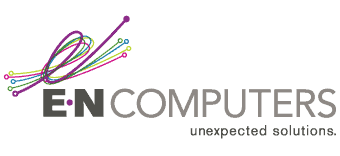

Content Contributor, E-N Computers
7+ years experience in healthcare IT and tech support.
Making sure that your team has access to shared resources such as a file server becomes more complex if you have multiple locations or a hybrid workforce. Each site has its own network that connects all the workers and resources. Because it only connects devices at one site, we call it a local area network (LAN). To share resources, the local networks need to be connected to each other.
When you connect groups of computers together over large distances, you create a wide area network (WAN). The Internet, for example, is a public WAN that connects computers all over the world. Businesses can use a private WAN to connect their offices in a stable and secure manner.
Traditionally, the way to do this was to lease dedicated Internet lines with a service level agreement (SLA). Your service provider would run these lines to each location and guarantee something like 99.9% uptime annually. But dedicated lines are slow by today’s standards; for example, a T1 line only has 1.5 Mbps of bandwidth. But businesses would pay thousands of dollars per month for slow speeds because of the contractually promised uptime. Thankfully, there are better ways to build a multi-site network today.
In this article, we’re going to explain the benefits of SD-WAN technology, how we use Cisco Meraki software and hardware to build cost-effective multi-site networks, and when you might need a more advanced SD-WAN solution instead. We’ll also cover what you should consider before signing up for a managed SD-WAN solution from your internet service provider. Let’s start by looking at what SD-WAN is and what benefits it provides.
QUICK ANSWER:
What is SD-WAN?
SD-WAN stands for “Software-defined Wide Area Network”. It involves a combination of hardware and software that makes connecting multiple sites easier, faster, and more cost-effective than traditional WAN solutions. At E-N Computers, we recommend Cisco Meraki network gear and find that it meets the needs of most small- and medium-sized businesses.
What Is SD-WAN?

Better connectivity. In an SD-WAN, network traffic can be routed over more connection types. Your offices can use a mix of cable, DSL, satellite, and even cellular 4G LTE to connect to one another. These connections are significantly cheaper that dedicated lines because they don’t have an SLA. SD-WAN allows you to lower costs without sacrificing uptime because it constantly monitors connection quality and auto-switches your Internet connection in case of an outage. Some SD-WAN solutions also offer traffic shaping and quality-of-service (QoS), which allows critical traffic like VoIP and web-based SaaS applications to be prioritized over other traffic and even accelerated.
Greater flexibility. To illustrate the flexibility of SD-WAN versus traditional WAN, you can think of SD-WAN as a taxi service and traditional WAN as a bus system with a central hub. If you need to add a new location to your network, an SD-WAN connection can be added in a matter of days (or even hours, if hardware and an Internet connection is already available), while getting a physical WAN link typically takes at least 45 days, if not months – if service is even available at the location. SD-WAN can even provide connectivity directly into employees’ homes for stable and secure work-from-home support.
Improved security. Centralized network management enables improved security in several ways. It makes it easier to apply security updates and policy changes. SD-WAN provides advanced analytics and remote monitoring abilities. Additionally, more problems can be resolved remotely, reducing the need for troubleshooting and repair by on-site technicians.
Cost Savings. According to Gartner, SD-WAN can provide significant cost savings by lowering capital expenditures, operational expenditures, and internet service costs. They found that hardware/software/support costs were 40% less while time spent managing the network was reduced 50 to 90%. And internet expenses were reduced by spreading the load across lower-cost connections.

Cisco Meraki SD-WAN

WATCH: Why We Love Cloud-Managed Networking
Meraki products make it easy to provide you with fail-over or load balancing by using two or more best-effort internet connections. For example, we can set up fiber and cable internet services where fiber is your primary connection to the outside. But if the fiber connection has an outage, your network will fail-over, or switch, to cable internet in under a minute. With load balancing, you can spread network activity across more than one internet connection so that none of them become bogged down and unresponsive. With this kind of arrangement, you can achieve high network uptime without the high costs of dedicated lines.
You get other benefits from using Meraki, too. Site-to-site VPN is simple to set up and ensures your offices can communicate securely and share resources. Client VPN makes it easy for remote workers to access the company network securely and easily. And you can prioritize critical work applications like VoIP calls, video calls, and other tools that depend on good network performance. As a result, your staff get the information they need, when they need it, without the aggravation of choppy audio and missed details.
Meraki is a great solution for most small and medium businesses, but there are scenarios where a more advanced SD-WAN solution is desirable. Services Like BigLeaf and VeloCloud provide features like faster failover detection, same-IP failover, and prioritization or “traffic shaping” for a greater number of applications. If temporary loss of connectivity would significantly disrupt a custom application, cause loss of life, or result in massive monetary damages, you should consider more complex, enterprise-grade SD-WAN products like these.
Video
Why We Love Meraki SD-WAN
A Caution About Managed SD-WAN

While talking with a potential client, we learned that an ISP had given them a quote for a managed SD-WAN solution for their four locations. We were able to design a similar Meraki solution that came out to about half the total cost, even with third-party financing over 60 months. In effect, we could provide that client with fully managed IT services and new hardware for the same monthly cost the ISP would charge just for connectivity. Beyond cost, there are other downsides to letting an ISP manage your network.
First, an ISP’s SD-WAN may not provide the level of support you expect. For example, the contract we mentioned did not include management of the Internet connections themselves – even those provided by the ISP itself! The client would be required to interface with each ISP in case of an outage, billing problem, or other issue. While this may be surprising, many ISPs have “bolted on” their SD-WAN services by purchasing a large MSP, meaning that even though they operate under the same brand, they are essentially a separate company from the ISP’s retail connectivity services.
Second, managed SD-WAN often comes with long contract terms and onerous cancellation policies. In this case, it was a 36-month term, with the entire value of the contract due in full if canceled within the first year, or 50% of the remaining contract value due if canceled in years 2-3. The contract also had onboarding fees, fees for out-of-scope work (like ISP management, as mentioned above), and other unfriendly language.
In contrast, E-N Computers provides network management as part of our fully managed IT services. Each of our clients rests assured that their network is secure, updated, and performing optimally. Regular network monitoring enables us to address issues early, reducing disruptions and security concerns.
If you are adding locations to your business, it might be time for a site-to-site network. A well-designed and well-maintained company network will support your business strategy and goals. Is your infrastructure completely optimized for your business strategy or is there room for improvement? Take our free five-minute IT Self-Assessment to find out where you stand and receive a list of actions you can take to improve your IT. Afterward, you can book a free strategy session to discuss your results.
Learn More About Business-IT Strategy
READ: What is Business-IT Strategy Alignment?
READ: Make Work-from-Home Tech Work For You
What is business-IT strategy alignment? Just like you need a business plan, you need an IT plan. By continually making sure these two plans align, you make better use of resources and set yourself up for success. Find out more in this article.
One example of aligning business and IT plans can be seen in the move to remote work. It’s not as simple as taking a laptop home from the office. Business processes have to adapt and different technology is need to ensure people can work wherever they are. Find out how to make remote work a success with this article.
Take the IT Maturity Assessment

Is your business ready to weather changes, including employee turnover? Find out by taking our IT maturity assessment.
You’ll get personalized action items that you can use to make improvements right away. Plus, you’ll have the opportunity to book a FREE IT strategy session to get even more insights into your IT needs.

Industries
Locations
Waynesboro, VA
Corporate HQ
215 Fifth St.
Waynesboro, VA 22980
Sales: 540-217-6261
Service: 540-885-3129
Accounting: 540-217-6260
Fax: 703-935-2665
Washington D.C.
1126 11th ST. NW
Suite 603
Washington, DC 20001-4366
Sales: 202-888-2770
Service: 866-692-9082
VA DCJS # 11-6604
Locations
Harrisonburg, VA
45 Newman Ave.
Harrisonburg, VA 22801
Sales: 540-569-3465
Service: 866-692-9082
Richmond, VA
3026A W. Cary St.
Richmond, VA 23221
Sales: 804-729-8835
Service: 866-692-9082
